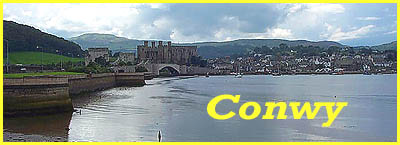
A Jewel In The Crown
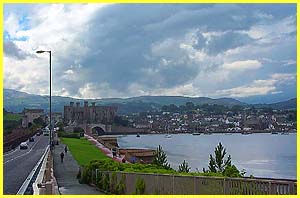 There are many jewels
in the crown of this corner of North Wales but Conwy is surely
one of the brightest. There are many jewels
in the crown of this corner of North Wales but Conwy is surely
one of the brightest.
Even when the weather is not at its best as seen here on the
right, the approach to the town from the east is nothing less
than impressive. Situated at the mouth of the Conwy estuary with
a backdrop of Snowdonia's mountains, the mediaeval castle immediately
draws the eye.
To reach the west bank and the town, most travellers from the
east cross the modern (1958) road bridge.
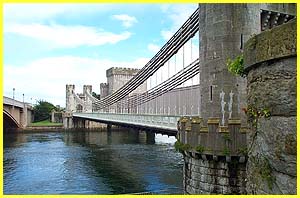 There
are in fact three bridges in close proximity across the river
but to me, by far the most impressive is Telford's Suspension
Bridge (left). There
are in fact three bridges in close proximity across the river
but to me, by far the most impressive is Telford's Suspension
Bridge (left).
Note the English spelling of Conwy on the plaque (below) that
adorns the bridge that is now used solely by pedestrian traffic.
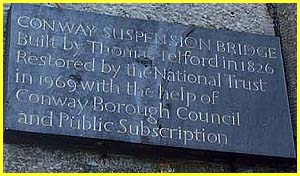
The photo below left shows all three bridges with, from left
to right, the modern road bridge, Telford's Suspension Bridge
and Stephenson's Tubular Railway Bridge (1848).
It is possible to compare the styles of architecture in the photo
below right and although both are great feats of engineering,
who do you think was more sympathetic to the existing mediaeval
architecture? No contest!
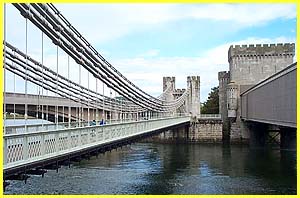 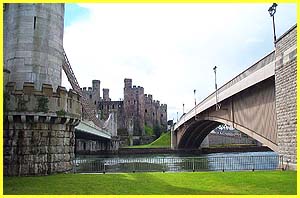
Equally Impressive From Both Sides Of The
River
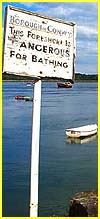 A better
view of Stephenson's bridge may be obtained from the west bank
but most tourists turn the opposite way after crossing the river
to explore the town. A better
view of Stephenson's bridge may be obtained from the west bank
but most tourists turn the opposite way after crossing the river
to explore the town.
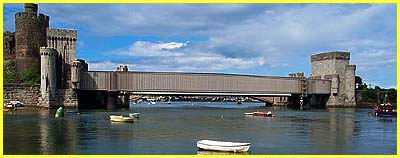
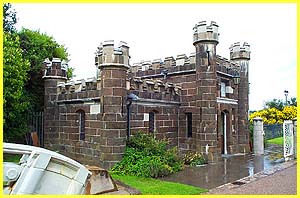
But to return to Telford's bridge, this Toll House has now been
restored by The National Trust and converted into a small museum.
Payment of a small fee not only gains admittance to the building
which is now furnished as it would have been over 100 years ago
but also permits the visitor to cross and examine this historic
landmark at close quarters.
Prior to 1826 and the construction of this bridge, the only way
to cross the river was by means of a ferry.
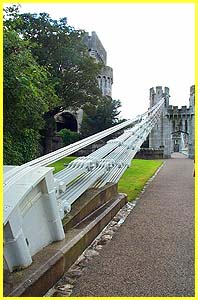 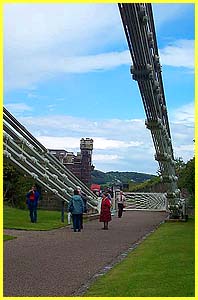 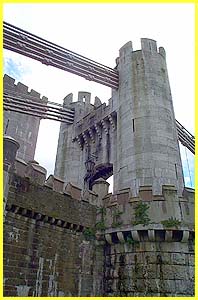
In 1826 Thomas Telford could not have envisaged the
phenomenal increase in the volume of traffic that would ensue
in the next century and even in 1958, the planners only succeeded
in creating a summer bottleneck in Conwy with the opening of
the new bridge.

Today much of the speeding traffic on the A55 misses Conwy altogether
by using the fourth crossing of the estuary - a road tunnel opened
in 1990. Who knows what tomorrow will bring?
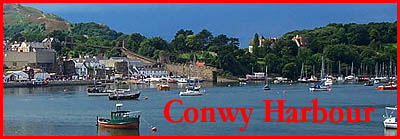
It's A Small World
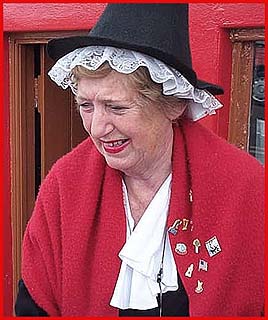 In
these days where we are often encouraged to "Think Big",
it is obvious that in times past the population of this part
of North Wales did the opposite. Not only can the area lay claim
to having the smallest church in Wales at Rhos-On-sea but Conwy
also claims to have Britain's smallest house. In
these days where we are often encouraged to "Think Big",
it is obvious that in times past the population of this part
of North Wales did the opposite. Not only can the area lay claim
to having the smallest church in Wales at Rhos-On-sea but Conwy
also claims to have Britain's smallest house.
They say the world is getting smaller. With the advent of modern
technology, national borders are easily breached as messages
fly across the internet from one side of the globe to the other
in minutes. Advances in transportation too have contributed to
the feeling of a diminishing planet but the modern technological
wonders that we now take for granted were far into the distant
future when this tiny dwelling was constructed on Conwy's quay
side many years ago.
There are many architectural features to be seen and admired
in Conwy, not least the impressive castle and town walls but
this minute mid-Victorian dwelling is surely the most novel.
The building, only 6 feet (1.8m) wide, is easily distinguished
by sporting a red painted frontage and it draws visitors to the
area like a magnet.
A jolly lady in National Dress bids welcome to visitors at the
threshold of Britain's smallest house.
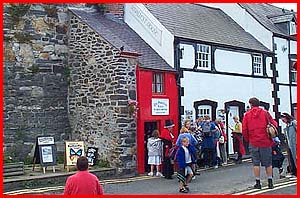 A magnet for visitors
to Conwy A magnet for visitors
to Conwy
Britain's Smallest House
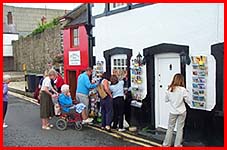
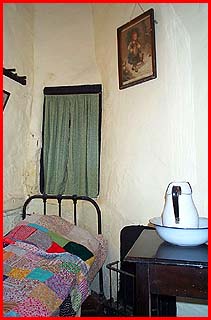 Estate agents would
have a field day when describing the one up, one down house to
prospective buyers but Moorland Publishing's Visitor's Guide
To North Wales And Snowdonia is probably more accurate with
its tongue in cheek phrase of "half-up and half-down".
It also informs that it was built by a bachelor who obviously
had no intention of changing that status. Estate agents would
have a field day when describing the one up, one down house to
prospective buyers but Moorland Publishing's Visitor's Guide
To North Wales And Snowdonia is probably more accurate with
its tongue in cheek phrase of "half-up and half-down".
It also informs that it was built by a bachelor who obviously
had no intention of changing that status.
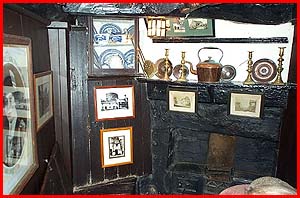
The picture on the left above was taken looking in from the front
door. A built in settle (not visible) with a hinged seat at the
bottom right corner of the photo doubled as a coal bunker. The
steep, narrow staircase is to the right of the fireplace and
leads directly to the bedroom. The photo on the right above was
taken from the top step. Ever heard the expression "Not
enough room to swing a cat round"? Well I think this is
where it must have originated.
|


 There are many jewels
in the crown of this corner of North Wales but Conwy is surely
one of the brightest.
There are many jewels
in the crown of this corner of North Wales but Conwy is surely
one of the brightest.  There
are in fact three bridges in close proximity across the river
but to me, by far the most impressive is Telford's Suspension
Bridge (left).
There
are in fact three bridges in close proximity across the river
but to me, by far the most impressive is Telford's Suspension
Bridge (left).


 A better
view of Stephenson's bridge may be obtained from the west bank
but most tourists turn the opposite way after crossing the river
to explore the town.
A better
view of Stephenson's bridge may be obtained from the west bank
but most tourists turn the opposite way after crossing the river
to explore the town.






 In
these days where we are often encouraged to "Think Big",
it is obvious that in times past the population of this part
of North Wales did the opposite. Not only can the area lay claim
to having the smallest church in Wales at Rhos-On-sea but Conwy
also claims to have Britain's smallest house.
In
these days where we are often encouraged to "Think Big",
it is obvious that in times past the population of this part
of North Wales did the opposite. Not only can the area lay claim
to having the smallest church in Wales at Rhos-On-sea but Conwy
also claims to have Britain's smallest house. A magnet for visitors
to Conwy
A magnet for visitors
to Conwy 
 Estate agents would
have a field day when describing the one up, one down house to
prospective buyers but Moorland Publishing's Visitor's Guide
To North Wales And Snowdonia is probably more accurate with
its tongue in cheek phrase of "half-up and half-down".
It also informs that it was built by a bachelor who obviously
had no intention of changing that status.
Estate agents would
have a field day when describing the one up, one down house to
prospective buyers but Moorland Publishing's Visitor's Guide
To North Wales And Snowdonia is probably more accurate with
its tongue in cheek phrase of "half-up and half-down".
It also informs that it was built by a bachelor who obviously
had no intention of changing that status.